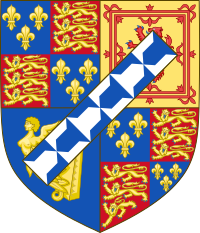Charles FitzCharles, 1st Earl of Plymouth(c. 1657 – 17 October 1680), was theillegitimateson of KingCharles II of EnglandandCatherine Pegge.He had a sister,Catherine,who is believed to have become a nun.[2]His mother went on to marry Sir Edward Greene ofSamfordinEssex,and had one child, Justinia Greene.[3]His subsidiary titles wereViscount TotnessandBaron Dartmouth.
The Earl of Plymouth | |
|---|---|
 1689 mezzotint | |
| Born | c.1657[1] Westminster,England |
| Died | 17 October 1680(aged 23) |
| Burial place | Westminster Abbey |
| Spouse | Lady Bridget Osborne |
| Parents | |

Plymouth died while serving as part of theTangier Garrison.
Life
editCharles FitzCharles was born in or about 1657. He was the illegitimate son ofCharles II of England,byCatherine Pegge,daughter of Thomas Pegge ofYeldersley,Derbyshire.[1]Charles II had the affair with Catherine (or Katherine) Pegge whilst he was abroad in exile. Charles the younger was allowed to use the Royal arms with a "baton sinister, Vaire.. and was bred to the sea".[3]He was educated abroad, probably in Spain[3]and he was known by the nickname of "Don Carlos".
Sir William Dugdalewrote,[4]giving much testimony of his singular accomplishments:
In the time of his youth, he was elevated to the peerage, 28 July 1675, asBaron of Dartmouth,Viscount Totness,andEarl of Plymouth,to the end he might be the more encouraged to persist in the paths of virtue, and thereby be the better fitted for the managery of great affairs when he should attain to riper years.
He married on 19 September 1678 atSt Mary's Church, Wimbledon,Surrey,Lady Bridget Osborne, third daughter ofThomas Osborne, 1st Duke of Leeds,Lord High Treasurer.[5]
He was a friend of the dramatic poet,Thomas Otway,for whom he procured a cornet's commission in a regiment of horse serving inFlanders.Later when his friend,John Sheffield, 1st Duke of Buckingham and Normanbyin consequence of his attachment to Queen Anne, then Princess of Denmark, was sent to theColony of Tangier,it was reported that the Duke was purposely despatched in a leaky vessel in order to get rid of him.[6]Nevertheless, the Earl of Plymouth, notwithstanding he was sensible of the danger, insisted on accompanying him.[6]
Death
editThe SultanMoulay IsmailofMoroccohad made an unsuccessful attempt to seize the town ofTangierin 1679, but ended upimposing a crippling blockade.The King's Own Royal Regimentwas formed on 13 July 1680 as the 2nd Tangier, or Earl of Plymouth's Regiment of Foot, with Charles as the founding Colonel. Charles died ofdysenterywithout issue on 17 October 1680, aged 23, and the English were ultimately forced to withdraw, ending theirpresence in Tangier.The title of Earl of Plymouth became extinct, but it was recreated two years later forThomas Hickman-Windsor, 7th Baron Windsor(1627–1687).
Plymouth's body was returned toEnglandand he was buried on 18 January 1681 inWestminster Abbey.[7]His wife, the Countess, remarried in 1706,Philip Bisse,Bishop of Hereford,and she died on 9 May 1718.[8]Bridget left the Bishop a widower and he erected a handsome tablet in her honour inHereford Cathedral.[3]
References
edit- ^abDictionary of National Biography,now in the public domain
- ^peerageaccessed October 2007
- ^abcdLiterary Anecdotes of the Eighteenth CenturyByJohn Nichols1812
- ^Sir William Dugdale, Baronage, iii. 487
- ^"Wimbledon Pages 519-540 The Environs of London: Volume 1, County of Surrey. Originally published by T Cadell and W Davies, London, 1792".British History Online.Retrieved6 July2020.
- ^abMemoirs of the Court of England During the Reign of the Stuarts: By John Heneage Jesse, 1855accessed 19 October 2007
- ^Chester, Registers of Westminster Abbey, p. 201
- ^Hist. Reg. 1718, Chron. Diary, p. 21; Political State, xv. 553